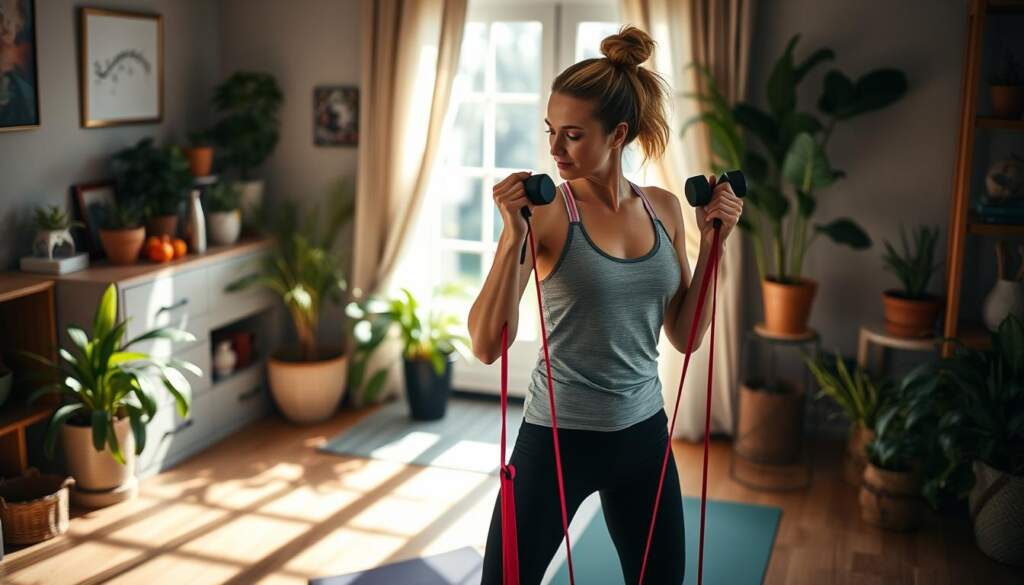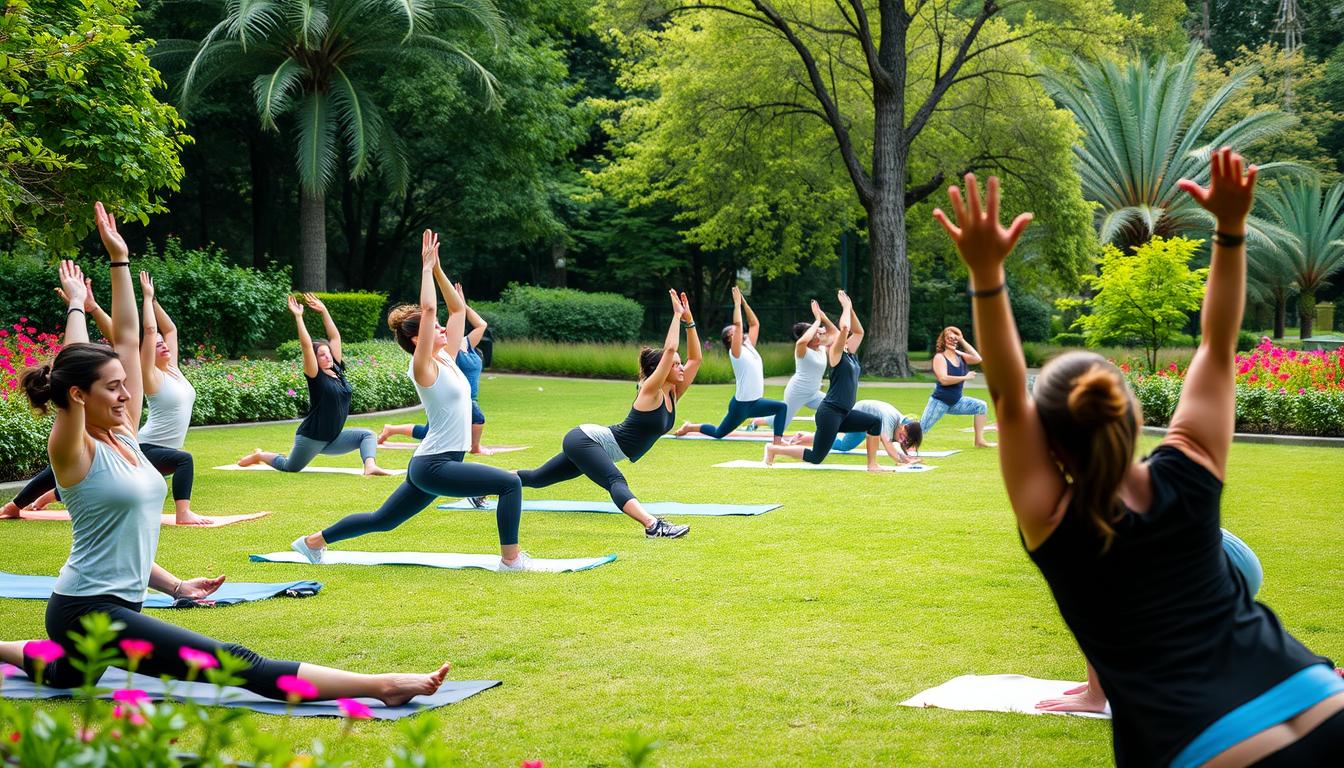Embarking on the journey toward enhanced physical fitness doesn’t mandate a gym membership. In fact, less than a quarter of U.S. adults are achieving the recommended levels of exercise1, indicating a substantial opportunity for gym alternatives that fit seamlessly into our daily lives. Staying active at home and leveraging home workout solutions can lead to substantial health benefits. Simple strides, such as walking for at least 30 minutes a day, can fortify heart health and hone one’s physical strength and endurance1. Meanwhile, diverse activities like yard work or household chores, far from mundane, double as effective calories torchers and contribute positively to your cardiovascular well-being12.
While engaging in these everyday exercises, remember that each extra step you take, including seemingly trivial motions like fidgeting, adds up to additional calories burned, potentially up to 350 calories per day1. And for those with limited mobility or spatial constraints, innovative options like wheelchair dancing1 and yoga offer means of engaging in physical fitness without equipment while equally contributing to mental serenity.
Key Takeaways:
- Identifying daily activities as potential exercises can promote staying active at home
- Dedicated workout sessions can often be successfully substituted with integrated home workout solutions
- Physical fitness without equipment is an attainable goal through various forms of movements and activities
- The American Heart Association’s exercise guidelines encourage regular and intentional exercise for all
- Gym alternatives like walking, dancing, and even gaming, can be powerful tools for maintaining health
- Adopting creative strategies such as a standing desk or using stairs can seamlessly increase activity levels
- Resources like local government programs and online communities can support structured exercise efforts
Understanding the Essentials of Intentional Exercise
Intentional exercise, distinct from routine physical activities, involves planned, structured efforts designed specifically to improve both physical and mental health. Leveraging such strategies not only aids in effective weight management but also plays a crucial role in enhancing overall well-being.
The Importance of Differentiating Physical Activity from Structured Exercise
While everyday physical activities like walking the dog or taking the stairs may increase our daily step count, structured exercise benefits such as aerobic fitness, strength training, and flexibility require intentional effort and planning. Engaging in deliberate physical activities like a brisk walk or light jogging can significantly alleviate stress, fostering a better mental and physical state3.
How Intentional Exercises Bolster Mental and Physical Health
Structured exercise routines extend beyond the scale, affecting deep-seated wellness goals. About 100% of individuals acknowledge the importance of exercise for health benefits that transcend mere weight loss4. Such consistent movement catalyzes a profound impact on overall well-being, as unanimously noted by experts4.
Moreover, activities suggested by professionals such as fostering a habit of morning workouts or using exercise to manage stress underscore the significant role of exercise in improving mental health4. These exercises become pivotal in not just shaping the body, but also in fortifying the mind and emotional resilience.
Guidelines by the American Heart Association for Weekly Exercise
Aiming to foster a structured exercise regimen, the American Heart Association recommends at least 150 minutes of moderate exercise or 75 minutes of vigorous activity per week. This could be segmented into daily routines that integrate well into personal schedules, ensuring sustainability and effectiveness.
Adhering to these guidelines not only aids in maintaining a healthy weight but also contributes substantially to cardiovascular health and stress reduction, proving why exercise is crucial for long-term health management.
Engage in intentional exercise consistently to harness its full spectrum of benefits, from physical fitness to enhanced mental clarity and emotional stability.
Walking: A Simple Path to Improved Health
Integrating walking into your daily routine is a straightforward start towards enhancing your health. Walking for a total of 150 minutes per week can substantially improve your overall well-being5. This form of easy exercise doesn’t require specialized equipment other than comfortable shoes, making it an accessible means to bolster cardiovascular fitness6.
Whether you’re taking a brisk walk around your neighborhood or a leisurely stroll in the park, you are actively contributing to your cardiovascular fitness and bone strength. Engaging in this activity increases your heart rate and promotes healthier density in your bones, crucial for overall vitality5.
Interestingly, even short intervals of walking, about 10 minutes each, accumulated throughout the day, can lead to these health benefits5. Setting realistic targets, like a brisk 10-minute daily walk, aligns with health guidelines suggesting 150 minutes of moderate exercise per week and can set the foundation for a healthier lifestyle7.


Moreover, diversity in your walking routine can enhance its benefits. Varying your pace and route makes the exercise mentally stimulating and physically challenging, which can help maintain your motivation. Alternating between a brisk pace and a gentle walk as part of interval training can maximize your calorie burn and improve your endurance5. Engaging activities like listening to your favorite podcast or music during walks can further enrich the experience, allowing you to enjoy the activity while staying focused and energized7.
Walking not only influences physical parameters but also mental acuity. Research underscores that individuals who engage in walking are likelier to produce a higher number of creative responses compared to those who remain sedentary6. For those looking to break into walking, joining a local walking group can be a fantastic way to start. It provides an opportunity to meet new people and share motivating goals, which significantly enhances the likelihood of turning walking into a regular health regime7.
In conclusion, walking for health is an incredibly beneficial and easy exercise that aids in maintaining cardiovascular fitness and improving bone strength. By merely walking more frequently, you can reap significant health benefits, effectively manage your weight, and enhance mental sharpness, setting a strong foundation for a healthier future.
Incorporating Strength Training into Your Daily Life
Embracing strength training at home not only caters to convenience but has been proven to offer significant health benefits ranging from muscle mass increase to enhanced metabolic rates. As advocated by expert organizations, integrating at-home strength exercises into your routine at least two to three times weekly is crucial for optimizing health. These activities help in boosting metabolism and enhancing overall physical strength89.
Strength training at home can effectively consist of exercises such as wall sits, planks, calf raises, superman, and push-ups. Such routines target all major muscle groups, ensuring a balanced approach to muscle development and overall body fitness8. Moreover, incorporating a variety of exercises like squats, lunges, curls, and sit-ups can substantially increase muscle mass and improve core strength, stability, and balance9.
Commitment to regular strength training enhances not just physical capabilities but also contributes to significant reductions in body fat and improvements in bone density and mental health. The positive effects on conditions like diabetes, heart disease, and arthritis are well-documented and adding exercises such as resistance band workouts can provide substantial resistance training akin to using free weights9.
Moreover, establishing a routine with a partner can significantly increase the likelihood of consistency due to the support and accountability it fosters8. Research also underscores the psychological benefits of exercise, including the reduction of stress and anxiety, improvements in mood, and even a bolstered immune system10.
- Start with simple exercises (e.g., squats and lunges) and gradually increase intensity.
- Include a variety of exercises to target different muscle groups.
- Maintain consistency by setting a regular schedule for workouts.
- Partner with a friend or family member to build accountability.
Exercising daily strengthens not just the body but also the mind, setting a positive tone for the entire day and promoting an active, healthy lifestyle10.
For those looking to introduce an effective strength training routine at home, consider using household items like chairs for wall sits or bottles of water as makeshift dumbbells. Such innovative approaches ensure that everyone can participate in these beneficial exercises, regardless of having traditional gym equipment at home8.
| Exercise | Major Muscle Groups Targeted | Recommended Repetitions |
|---|---|---|
| Wall Sits | Lower body (Quads, Glutes) | 3 sets of 30 seconds |
| Planks | Core (Abs, back) | 3 sets of 20 seconds |
| Calf Raises | Lower legs | 2 sets of 15 |
| Push-Ups | Upper body (Chest, shoulders, triceps) | 3 sets of 12 |


Bodyweight Exercises: An Effective Workout Without the Gym
Maintaining your fitness routine doesn’t require expensive gym memberships or elaborate equipment. Bodyweight exercises are a cost-effective and powerful way to build muscle, improve flexibility, and enhance overall health, making them an excellent choice for a home workout regimen. These exercises are not only simple to perform but also highly effective, ensuring that you can stay active and healthy regardless of your location.
The Many Benefits of Planks, Push-Ups, and Squats
One of the cornerstones of bodyweight training is the plank, an exercise renowned for its planks benefits in core strength and stability. A study has demonstrated that performing planks with reach-under — completing 3 sets of 20 taps — will significantly work your core muscles11. Push-ups are equally beneficial, offering vast push-up advantages, such as enhancing upper body strength and muscle mass; studies show that push-ups with a load similar to 40% of a 1-rep max bench press can lead to comparable muscle hypertrophy and strength gains over an 8-week period12. Squats, a staple in many fitness regimens, are celebrated for squats for fitness, as they target the legs and glutes; pistol squats specifically engage numerous muscle groups and strengthen leg muscles12.
Isometric Holds and Their Impact on Muscle Strength
For those seeking to improve muscle strength, isometric holds, such as wall sits, provide a challenging workout that engages multiple muscle groups. This type of exercise promotes calorie burn and can be intensified progressively as fitness levels improve. The inherent scalability of bodyweight exercises, including isometric holds, allows both novices and seasoned athletes to efficiently challenge themselves. An expert from Kennesaw State University elucidated that bodyweight workouts, like a 20-minute CrossFit routine consisting of pull-ups, push-ups, and squats, offered greater training stimulus than running at 85% of maximal heart rate for the same duration, which underscores the impact and effectiveness of these exercises12.
With the ability to do them almost anywhere, bodyweight exercises blend convenience with potency, forming the backbone of a robust, gym-free fitness regimen. As research and fitness professionals attest, these exercises are not just placeholders for more complex workouts; they are foundational moves that can lead to substantial gains in strength, endurance, and overall physical health1112.
FAQ
How can I stay active without going to a gym?
What is intentional exercise and why is it important?
How do structured exercises benefit mental and physical health?
What are the American Heart Association’s exercise guidelines?
Why is walking considered an effective form of exercise?
Can strength training be effectively done at home?
What are the benefits of incorporating planks, push-ups, and squats into my routine?
How do isometric holds like wall sits contribute to muscle strength?
Source Links
- Exercising Without a Gym – https://www.apwuhp.com/exercise-without-going-to-the-gym/
- 6 Healthy Ways to Exercise Without the Gym – Radish Health – https://radish.health/blog/6-healthy-ways-exercise-without-gym/
- 7 Ways to Be Intentionally Active (Without Going to the Gym) – https://lifestyleguide.com/article/ways-intentionally-active-without-going-gym
- Why I Exercise: Real People on What Keeps Them Going – https://www.healthline.com/health/fitness/why-i-exercise
- Walk your way to fitness – https://www.mayoclinic.org/healthy-lifestyle/fitness/in-depth/walking/art-20046261
- Walking: An Easy Way to Get Fit – HelpGuide.org – https://www.helpguide.org/wellness/fitness/how-to-start-a-walking-program
- Walking for health – https://www.nhs.uk/live-well/exercise/walking-for-health/
- 12 exercises you can do without going to the gym – https://www.nebraskamed.com/weight-loss/exercising-without-the-gym
- Strength Training at Home: Workouts With and Without Equipment – https://www.healthline.com/health/exercise-fitness/strength-training-at-home
- Home Workout and Fitness Tips: Exercising without the Gym – https://www.helpguide.org/wellness/fitness/exercise-during-coronavirus
- 13 Moves That Let You Build Muscle Without Weights – https://www.healthline.com/health/fitness-nutrition/no-weight-workout
- 31 Bodyweight Exercises to Pack on Muscle at Home – https://www.menshealth.com/uk/building-muscle/a756325/10-best-bodyweight-exercises-for-men/





